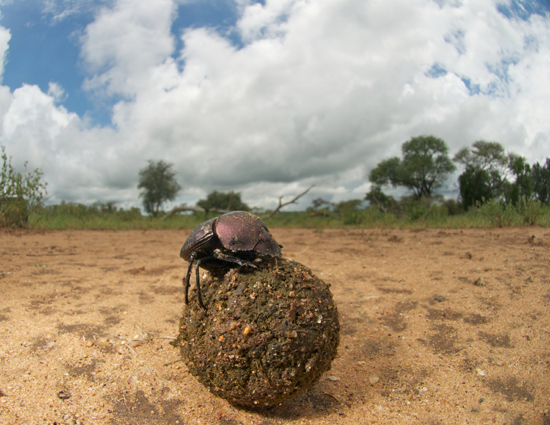
Marcus Byrne begins today’s talk with the words: “What I want to do today is share my passion for poo with you.”
But before you delve into a Freudian analysis, you should probably know that Byrne is an entomologist who studies dung beetles, of which there are about 6,000 species across the planet. As Byrne shares, “This animal has a brain size of grain of rice and yet it can do things that you and I couldn’t possibly entertain the idea of doing.”
[ted id=1628 width=560 height=315]
Dung beetles feed and grow their larvae in animal excrement, which they roll to their nest over great distances. They roll these balls of dung, which are physically bigger than their bodies, with their head down and walking backwards — a posture Byrne calls “the most bizarre way to transport your food.” Dung beetles are exceptionally good at this rolling maneuver, as there is intense competition among them.
Byrne and his team of researchers noticed that, every time an obstacle appeared on a dung beetle’s journey, it climbed onto its ball and did a little dance. To hear more about how this choreographed maneuver helps the dung beetle chart direct paths home and also gives their hands a break from the hot desert ground, watch this laugh-out-loud talk. And below, watch six more TED Talks which contain great trivia about beetles.
[ted id=1490 width=560 height=315]
Rives: Reinventing the encyclopedia game
Did you know that 25% of life on earth is beetle? And that even fireflies are technically beetles? Or that the scarab is beetle-shaped because the dung beetle’s journey across the desert reminded Egyptians of their god Khepri, who brings the sun every morning? These are just a few of the many facts you’ll learn in this mind-bending talk from the TEDxSummit in Doha.
[ted id=1072 width=560 height=315]
Michael Pawlyn: Using nature’s genius in architecture
A beetle can detect a fire from 80 kilometers away — 10,000 times the distance of man-made fire detectors. In this talk from TEDSalon London 2010, Michael Pawlyn wonders if we can mimic this incredible super-sensing. As he says, “You could look at nature as being like a catalog of products and all of those have benefitted from a 3.8-billion-year research and development phase.”
[ted id=1185 width=560 height=315]
Jonathan Drori: The beautiful tricks of flowers
Flowers can be deceiving. In this talk from TEDSalon London 2011, Jonathan Drori takes a look at a flower that has mimicked the glossy metallic surface of a beetle.
[ted id=614 width=560 height=315]
Janine Benyus: Biomimicry in action
A beetle is made of one material — chitin. And yet this material is amazingly versatile — it’s strong, waterproof, allows air to pass through it, and can become different colors. In this talk from TEDGlobal 2009, Janine Benyus wonders: can we create a material that serves so many purposes? Because while a beetle is made of one polymer, a potato chip bag is made of 350.
[ted id=422 width=560 height=315]
Steven Strogatz on sync
Fun fact: fisherman use beetles as beacons when finding their way through the oceans and down rivers. In this talk from TED2004, Steven Strogatz gives a peek at tiny beetles that grow so bright underwater that they can guide ships.
[ted id=1103 width=560 height=315]
Paul Root Wolpe: It’s time to question bio-engineering
DARPA, the United States’ Defense Research Agency, has experimented on giant beetles, placing computer chips on their back and wiring their wings. In this talk from TEDxPeachTree Paul Root Wolpe sounds a warning bell and asks: is this type of thing ethical?
.
Has your mind been changed about beetles? Watch our playlist of more amazing animals with bad reputations »
Comments (3)
Pingback: Iced Borscht » lInKaGeS
Pingback: What is it about bees? Three experts discuss why they’re fascinating, why they’re dying and what can save them | TokNok Multi Social Blogging Solutions
Pingback: In Short: J.J. Abrams to direct “Star Wars,” scientists investigate storing audio on DNA | Krantenkoppen Tech